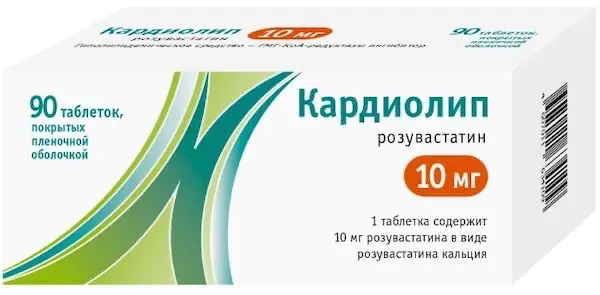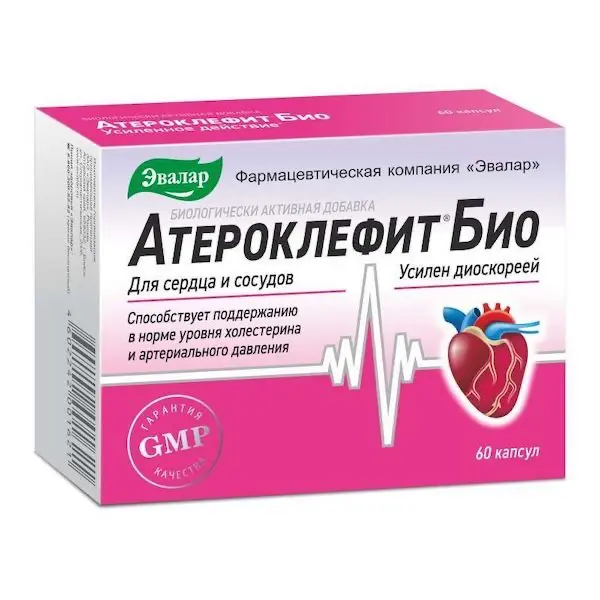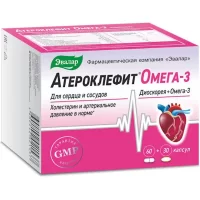Description
Cardiolip Pharmacodynamics
Hypolipidemic drug, selective competitive inhibitor of HMG CoA reductase enzyme, which converts 3-hydroxy-3-methylglutaryl-CoA into mevalonate, cholesterol (CH) precursor. The main target of rosuvastatin action is the liver, where the synthesis of cholesterol and catabolism of low-density lipoproteins (LDL) take place. Rosuvastatin increases the number of LDL receptors on the surface of liver cells, increasing capture and catabolism of LDL, which in turn leads to inhibition of synthesis of very low density lipoproteins (VLDL), thereby reducing the total amount of LDL and VLDL.
Rosuvastatin reduces elevated concentrations of LDL cholesterol (LDL-C), total cholesterol (TC), triglycerides (TG), increases the concentration of high-density lipoprotein cholesterol (HDL-C), and decreases the concentration of apolipoprotein B (apoB), LDL-C, TG-LDL-C and increases the concentration of apolipoprotein A-I (apoA-I). As a result of the action of rosuvastatin, a decrease in the coefficient (index) of atherogenicity is observed, which characterizes the improvement of the lipid profile in patients with hypercholesterolemia.
Atherogenicity index = (CHC – HDL-C) / HDL-C.
The therapeutic effect develops within one week after the start of treatment with rosuvastatin. The maximum therapeutic effect is usually reached by the 4th week of therapy and is maintained with regular administration of the drug.
Effective in adult patients with hypercholesterolemia, with or without hypertriglyceridemia, including patients with diabetes mellitus and familial hypercholesterolemia.
Additive effect is observed in combination with fenofibrate (with regard to TG concentration) and with nicotinic acid in lipid-lowering doses (with regard to HDL-C concentration), but the possibility of such combinations should be decided by the treating physician taking into account possible risks (see also section “Special indications”).
Indications
– Primary Fredrickson hypercholesterolemia (type IIa, including familial heterozygous hypercholesterolemia) or mixed hypercholesterolemia (type IIb) as an adjunct to diet when diet and other non-pharmacological treatments (e.g. exercise, weight loss) are not sufficient;
– familial homozygous hypercholesterolemia as an adjunct to diet and other lipid-lowering therapy (e.g., LDL-apheresis), or in cases where such therapy is not sufficiently effective;
– hypertriglyceridemia (type IV according to Fredrickson classification) as an adjunct to diet;
– for slowing the progression of atherosclerosis as an adjunct to the diet in patients who are indicated for therapy to reduce total cholesterol and LDL-C concentrations;
– primary prevention of major cardiovascular complications (stroke, infarction, arterial revascularization) in adult patients without clinical signs of CHD, but with an increased risk of its development (age over 50 years for men and over 60 years for women), increased concentration of C-reactive protein (≥ 2 mg/l) in the presence of at least one additional risk factor, such as hypertension, low concentration of HDL-C, smoking, family history of early-onset CHD.
Contraindications
– Hypersensitivity to rosuvastatin or any of the drug components;
– Children under 18 years of age;
– Liver disease in active phase, including a persistent increase in serum transaminase activity and any increase in serum transaminase activity (more than 3 times the upper limit of normal);
– severe renal dysfunction (CKG less than 30 ml/min);
– myopathy and predisposition to myotoxic complications;
– concomitant use of cyclosporine;
– in women: pregnancy, breastfeeding, lack of adequate contraceptive methods.
Dosage and administration
- Inside, do not chew or crush the tablet, swallow it whole with water. The drug can be administered at any time of the day, regardless of the time of food intake.
- Before starting therapy with the drug Kardiolip, the patient must begin a standard hypocholesterolemic diet and continue to follow it during treatment. The drug dose should be adjusted individually depending on the goals of therapy and the therapeutic response to treatment, taking into account current recommendations for target lipid concentrations.
- The recommended starting dose for patients starting to take the drug or for patients transferred from other HMG-CoA reductase inhibitors should be 5 or 10 mg of Cardiolip once daily. When choosing the initial dose, individual cholesterol content should be taken into account and the possible risk of cardiovascular complications should be taken into account, as well as the potential risk of side effects should be assessed. If necessary, the dose may be increased to a larger one in 4 weeks (see section “Pharmacodynamics”).
- Due to the possible development of side effects at a dose of 40 mg, compared to lower doses of the drug (see section “Side effects”). Due to the possible development of side effects of 40 mg dose compared to lower doses of the drug (see section “Side effects”), dose increase to 40 mg, after additional dosing above the recommended initial dose during 4 weeks of therapy, may be conducted only in patients with severe hypercholesterolemia and with high risk of cardiovascular complications (especially in patients with familial hypercholesterolemia), in whom the desired therapy result was not reached when taking 20 mg dose and will be under the supervision of a specialist (see section “Special indications”). Particularly close monitoring of patients receiving a dose of 40 mg is recommended.
- It is not recommended to prescribe the 40 mg dose to patients who have not previously seen a physician.
- After 2-4 weeks of therapy and/or when increasing the dose of Cardiolipus it is necessary to monitor lipid metabolism parameters (if necessary, the dose should be adjusted). The use of the drug in a higher dose than 40 mg is not justified in connection with the increase in the side effects and in most cases is not recommended.
- Elderly patients
No dose adjustment is required.





